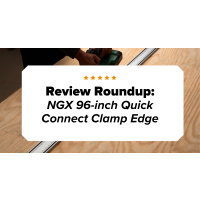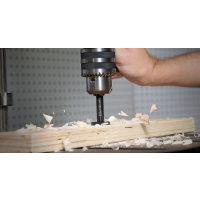One of the most important lessons in any DIY journey is that good, sharp tools make all the difference. That means purchasing the best that the budget allows but also doing some homework on what your needs might be in the future. Getting that balance right from the start is huge in propelling you forward for success no matter the job at hand. This is particularly true when selecting saw blades for your circular saw, miter saw, or table saw.
You should familiarize yourself with the types of blades that are out there, what they do and why you need them. Below are four solid tips to help you shop for saw blades that could make the difference between a failed build or workshop glory.
Make & Design
The basic form for all blades is its circular shape, which is cut from a piece of plate steel before being heat treated. However, the defining factor of quality is whether or not your blade body is tensioned. A tensioning operation will form a slight but noticeable ring in the blank between the arbor hole for the saw arbor and the teeth. This operation promotes balance and true running while mounted to your saw. Other operations such as noise reduction slots are a bonus, especially if you are running the blade for longer periods.
The point here is that it’s important to research how your blade is made so that you can find one that fits your need and your budget. Understanding the manufacturer’s process will match their know-how with your expectations.
Tooth Count
You probably already know that tooth count is important. When choosing blades, you’ll want to weigh these three factors: the material you’re building with, the finish quality you want, and your budget for this build. It’s recommended that you have multiple blades — one of each type of tooth count as listed below — as the different tooth counts serve different purposes. The following is a good guide for tooth count:
- Less than 30T = Rougher (rip) cuts
- Between 40 to 50T = Combination cuts
- Greater than 60T = Crosscuts
Tooth Geometry
The teeth on your blade do the cutting — and like any cutting tool, their design is critical to performance and finish. When you use a blade that not only has the right number of teeth, but also has the correct geometry will give you the results you need in terms of quality and speed. There are about a half-dozen common grinds that fit a wide variety of jobs, the type of cut to the type of material you’re cutting. Most blade packaging has recommendations for blade use. Just match the blade to the material you’re using.
Hook Angle
You might ask: what is a hook angle, and why it is important? This angle is essentially how aggressively the blade tooth is presented to the material — with the aggressiveness increasing as the angles get larger. For instance, a more aggressive hook angle (20 degrees) on ripping blades helps you break down materials faster, while blades designed for high-end sheet goods or non-ferrous metals have a more sedate blade angle (5 degrees to 0 degrees, respectively). This slows the cutting action slightly and produces a finer finish.
At its most basic level, the hook angle is how the cutting tip of the blade is presented to the material. You could argue that this small, often forgotten specification is the most important.
So, the question remains: which blade to buy? Based on what we’ve said so far, you’re looking for quality manufacturing, the right tooth count, the appropriate tooth geometry, and the right hook angle for the job. Those four basics should inform your buying decision. You can certainly dig deeper to learn more about each of these blade characteristics, but armed with what we’ve talked about here, you should be able to successfully shop for the blades you need.
We’ve listed a couple resources below that can help you learn even more about shopping for a circular saw blade. It really is worth a little time to wade through it. Happy woodworking!
"Guide to choosing a 10” saw blade" chart from CMT Orange Tools
"Essential Table Saw Blades" from Popular Woodworking






